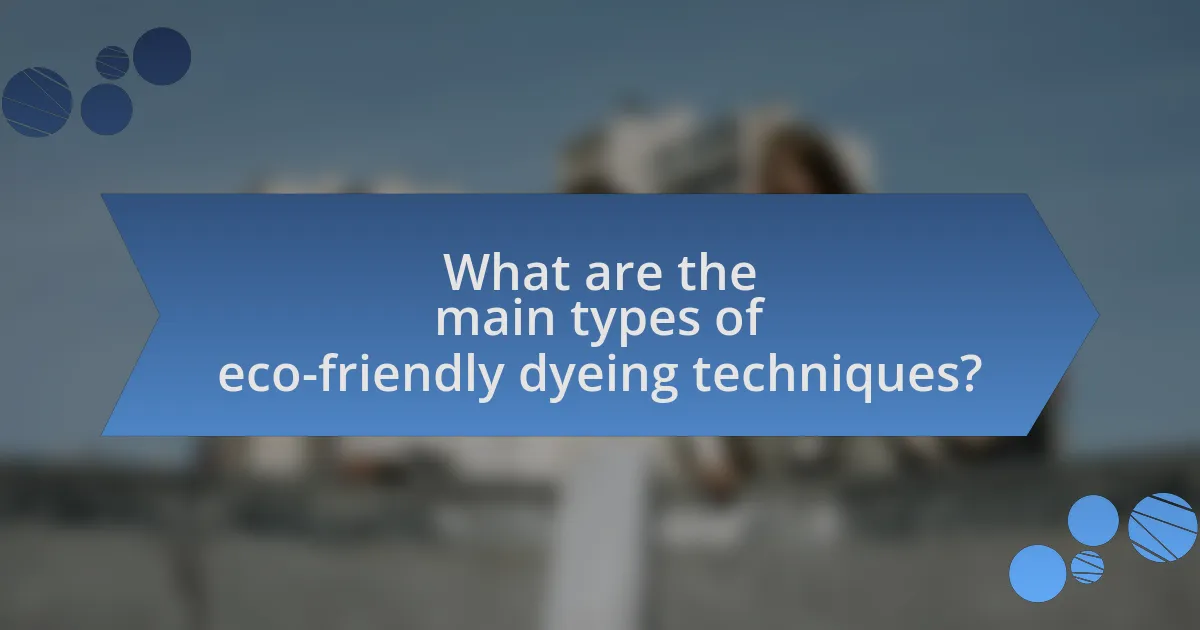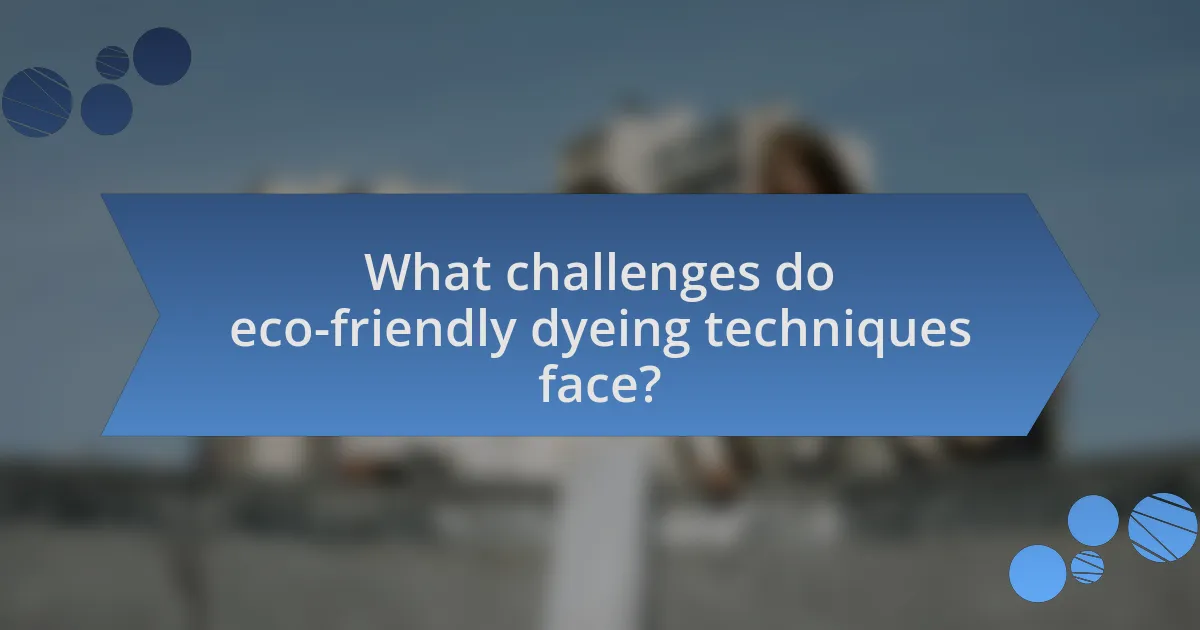Innovations in eco-friendly dyeing techniques focus on sustainable practices that minimize environmental impact in the textile industry. Key advancements include the use of natural dyes, waterless dyeing processes, and digital printing technologies, which collectively reduce reliance on synthetic chemicals and significantly lower water consumption. The article explores how these methods differ from traditional dyeing, the environmental challenges posed by conventional practices, and the growing consumer demand for sustainable options. Additionally, it addresses the economic barriers to adopting eco-friendly techniques and highlights best practices for implementation, emphasizing the importance of collaboration and consumer education in promoting these innovations.

What are Innovations in Eco-Friendly Dyeing Techniques?
Innovations in eco-friendly dyeing techniques include the use of natural dyes, waterless dyeing processes, and digital printing technologies. Natural dyes, derived from plants, minerals, and insects, reduce reliance on synthetic chemicals and are biodegradable. Waterless dyeing processes, such as supercritical CO2 dyeing, significantly minimize water usage, with some methods using up to 90% less water than traditional dyeing. Digital printing technologies allow for precise application of dyes, reducing waste and enabling on-demand production, which further decreases environmental impact. These advancements collectively contribute to a more sustainable textile industry by lowering pollution and resource consumption.
How do these innovations differ from traditional dyeing methods?
Innovations in eco-friendly dyeing techniques differ from traditional dyeing methods primarily by utilizing sustainable materials and processes that reduce environmental impact. Traditional dyeing often relies on synthetic dyes and large quantities of water, leading to pollution and resource depletion. In contrast, eco-friendly innovations employ natural dyes derived from plants, minerals, or waste materials, significantly lowering chemical usage and water consumption. For instance, techniques such as waterless dyeing and digital printing minimize water usage by up to 90% compared to conventional methods. These advancements not only enhance sustainability but also promote the use of biodegradable materials, aligning with global efforts to reduce textile waste and pollution.
What environmental impacts do traditional dyeing methods have?
Traditional dyeing methods have significant environmental impacts, primarily due to the use of toxic chemicals and large quantities of water. These methods often involve synthetic dyes that contain harmful substances, which can contaminate water sources and harm aquatic life. For instance, the textile industry is responsible for discharging approximately 20% of global wastewater, much of which contains these hazardous chemicals. Additionally, traditional dyeing processes can lead to soil degradation and loss of biodiversity due to the cultivation of dye plants and the pollution generated during dye production.
What are the key features of eco-friendly dyeing innovations?
Eco-friendly dyeing innovations primarily feature the use of natural dyes, reduced water consumption, and non-toxic chemicals. Natural dyes, derived from plants, minerals, and insects, minimize environmental impact compared to synthetic dyes, which often contain harmful substances. Innovations in dyeing techniques, such as digital printing and waterless dyeing methods, significantly reduce water usage, with some processes using up to 90% less water than traditional methods. Additionally, advancements in biodegradable and non-toxic chemicals ensure that the dyeing process does not contribute to pollution, aligning with sustainable practices in the textile industry. These features collectively enhance the sustainability of dyeing processes while maintaining quality and color vibrancy.
Why is there a growing demand for eco-friendly dyeing techniques?
There is a growing demand for eco-friendly dyeing techniques due to increasing consumer awareness of environmental issues and the negative impacts of traditional dyeing processes. Traditional dyeing often involves toxic chemicals and significant water usage, leading to pollution and resource depletion. According to a report by the Global Fashion Agenda, the fashion industry is responsible for 20% of global wastewater, highlighting the urgent need for sustainable practices. Eco-friendly dyeing techniques, such as natural dyes and waterless dyeing technologies, offer alternatives that reduce environmental harm and align with consumer preferences for sustainable products. This shift is further supported by regulatory pressures and initiatives aimed at promoting sustainability in manufacturing processes.
What consumer trends are driving this demand?
The demand for eco-friendly dyeing techniques is driven by increasing consumer awareness of environmental sustainability. Consumers are increasingly prioritizing products that minimize ecological impact, leading to a preference for brands that utilize sustainable practices. According to a 2021 survey by McKinsey, 67% of consumers consider sustainability when making purchasing decisions, highlighting a significant shift towards eco-conscious consumption. Additionally, the rise of social media has amplified the visibility of sustainable brands, influencing consumer behavior and preferences. This trend is further supported by the growing availability of eco-friendly alternatives, making it easier for consumers to choose sustainable options in their purchasing habits.
How do regulations influence the adoption of eco-friendly practices?
Regulations significantly influence the adoption of eco-friendly practices by establishing mandatory standards that businesses must meet to operate legally. For instance, regulations such as the European Union’s REACH (Registration, Evaluation, Authorisation and Restriction of Chemicals) compel companies to limit the use of harmful substances in their products, thereby encouraging the adoption of safer, eco-friendly alternatives. Additionally, financial incentives and penalties associated with compliance or non-compliance further motivate businesses to implement sustainable practices. Research indicates that companies adhering to stringent environmental regulations often experience enhanced brand reputation and consumer trust, which can lead to increased market share.

What are the main types of eco-friendly dyeing techniques?
The main types of eco-friendly dyeing techniques include natural dyeing, low-impact synthetic dyeing, and digital printing. Natural dyeing utilizes plant-based or mineral sources to create dyes, significantly reducing environmental impact compared to conventional methods. Low-impact synthetic dyeing employs dyes that require less water and energy, and are free from harmful chemicals, thus minimizing pollution. Digital printing, which uses inkjet technology, reduces water usage and waste by applying dye directly onto fabric, allowing for precise designs without the need for extensive dye baths. These techniques collectively contribute to sustainable practices in the textile industry.
How do natural dyes compare to synthetic dyes?
Natural dyes are generally considered more environmentally friendly than synthetic dyes, as they are derived from renewable resources and often biodegradable. In contrast, synthetic dyes are typically petroleum-based, leading to environmental concerns regarding their production and disposal. Studies indicate that natural dyes can have lower toxicity levels and reduced ecological impact, while synthetic dyes may contain harmful chemicals that can pollute water sources. For instance, the production of synthetic dyes often involves toxic substances like azo compounds, which can be hazardous to both human health and aquatic life.
What sources are used for natural dyes?
Natural dyes are derived from various sources, including plants, insects, and minerals. Plant sources encompass roots, leaves, flowers, and fruits, with examples such as indigo from the indigo plant, madder from the madder root, and turmeric from the turmeric root. Insect sources include cochineal, which is harvested from cochineal bugs, providing a vibrant red dye. Mineral sources consist of earth pigments like ochre and umber. These sources have been historically utilized for their colorfast properties and environmental benefits, making them integral to eco-friendly dyeing techniques.
What are the advantages and disadvantages of using natural dyes?
Natural dyes offer several advantages, including being biodegradable, non-toxic, and derived from renewable resources, which makes them environmentally friendly. They can produce vibrant colors and have historical significance in traditional textile practices. However, disadvantages include limited colorfastness, which can lead to fading over time, and the potential for higher costs and labor intensity in sourcing and processing natural materials compared to synthetic dyes. Additionally, the color range may be less diverse, and the dyeing process can be more variable, depending on factors such as plant source and extraction methods.
What innovative technologies are being used in eco-friendly dyeing?
Innovative technologies used in eco-friendly dyeing include digital printing, waterless dyeing methods, and the use of natural dyes derived from plants and minerals. Digital printing minimizes water usage and chemical waste by applying dye directly onto fabric, significantly reducing the environmental impact compared to traditional methods. Waterless dyeing technologies, such as supercritical CO2 dyeing, eliminate the need for water altogether, further decreasing resource consumption. Additionally, natural dyes sourced from renewable materials not only reduce reliance on synthetic chemicals but also promote biodiversity and sustainability in the dyeing process. These advancements collectively contribute to a more sustainable textile industry.
How does waterless dyeing technology work?
Waterless dyeing technology works by utilizing methods that eliminate the need for water in the dyeing process, primarily through the use of supercritical carbon dioxide (CO2) or other solvent-based systems. This technology allows dyes to be applied to fabrics in a gaseous state, which penetrates the material without the use of water, significantly reducing water consumption and pollution associated with traditional dyeing methods. For instance, the use of supercritical CO2 can reduce water usage by up to 90% compared to conventional dyeing processes, making it a more sustainable option in the textile industry.
What role does digital printing play in eco-friendly dyeing?
Digital printing significantly contributes to eco-friendly dyeing by minimizing water usage and reducing chemical waste. Traditional dyeing methods often require large quantities of water and produce harmful effluents, whereas digital printing utilizes inkjet technology that applies dye directly onto the fabric, resulting in up to 90% less water consumption. Additionally, digital printing allows for precise color application, which reduces the amount of dye needed and limits excess runoff. This method also enables the use of water-based inks that are less harmful to the environment, further supporting sustainable practices in the textile industry.

What challenges do eco-friendly dyeing techniques face?
Eco-friendly dyeing techniques face several significant challenges, primarily related to cost, scalability, and colorfastness. The production of natural dyes often requires more raw materials and labor compared to synthetic dyes, leading to higher costs. Additionally, many eco-friendly methods lack the scalability needed for large-scale textile production, making it difficult for manufacturers to adopt these practices widely. Furthermore, achieving colorfastness, which is the resistance of a dye to fading or running, can be problematic with natural dyes, as they may not adhere as effectively to fabrics as synthetic alternatives. These challenges hinder the broader implementation of eco-friendly dyeing techniques in the textile industry.
What are the economic barriers to adopting eco-friendly dyeing methods?
The economic barriers to adopting eco-friendly dyeing methods include high initial investment costs, limited access to sustainable raw materials, and the potential for increased operational expenses. High initial investment costs arise from the need for advanced technology and equipment that meet eco-friendly standards, which can deter manufacturers from transitioning. Limited access to sustainable raw materials, such as organic dyes, can lead to supply chain challenges and higher prices, making it economically unfeasible for some businesses. Additionally, the potential for increased operational expenses, due to the need for specialized training and compliance with environmental regulations, can further hinder adoption. These factors collectively create a challenging economic landscape for the widespread implementation of eco-friendly dyeing methods.
How do production costs compare between eco-friendly and traditional methods?
Production costs for eco-friendly methods are generally higher than those for traditional methods. This is primarily due to the use of more expensive raw materials, advanced technology, and the need for specialized processes that minimize environmental impact. For instance, a study published in the Journal of Cleaner Production found that eco-friendly dyeing processes can cost up to 30% more than conventional dyeing methods, largely because of the investment in sustainable materials and technologies. Additionally, while traditional methods may have lower upfront costs, they often incur higher long-term environmental costs, which can affect overall economic sustainability.
What are the scalability issues associated with eco-friendly dyeing?
Scalability issues associated with eco-friendly dyeing primarily include high production costs, limited availability of sustainable raw materials, and the need for specialized equipment. High production costs arise from the use of natural dyes and eco-friendly processes, which often require more labor and time compared to conventional dyeing methods. Limited availability of sustainable raw materials, such as organic cotton or plant-based dyes, restricts large-scale production and can lead to supply chain challenges. Additionally, specialized equipment needed for eco-friendly dyeing processes may not be widely accessible, further complicating scalability. These factors collectively hinder the widespread adoption of eco-friendly dyeing techniques in the textile industry.
How can the industry overcome these challenges?
The industry can overcome challenges in eco-friendly dyeing techniques by adopting advanced technologies such as digital printing and bio-based dyes. These innovations reduce water usage and chemical waste significantly; for instance, digital printing can cut water consumption by up to 90% compared to traditional methods. Additionally, the use of bio-based dyes, derived from natural sources, minimizes environmental impact and enhances sustainability. Implementing these technologies not only addresses ecological concerns but also meets consumer demand for sustainable practices, as evidenced by a growing market trend where 66% of consumers are willing to pay more for sustainable brands.
What role do collaborations play in advancing eco-friendly dyeing techniques?
Collaborations play a crucial role in advancing eco-friendly dyeing techniques by facilitating knowledge sharing, resource pooling, and innovation. When textile manufacturers partner with researchers, environmental organizations, and technology developers, they can leverage diverse expertise to create sustainable dyeing processes. For instance, collaborations have led to the development of natural dyes derived from agricultural waste, significantly reducing environmental impact. A notable example is the partnership between the fashion brand Stella McCartney and the University of Cambridge, which resulted in the creation of biodegradable dyes that minimize water pollution. Such collaborative efforts not only enhance the effectiveness of eco-friendly practices but also accelerate the adoption of sustainable technologies across the industry.
How can consumer education contribute to the adoption of these techniques?
Consumer education can significantly contribute to the adoption of eco-friendly dyeing techniques by increasing awareness and understanding of their benefits. When consumers are informed about the environmental impact of traditional dyeing methods, they are more likely to choose sustainable alternatives. For instance, studies show that consumers who are educated about the harmful effects of synthetic dyes on water pollution and human health tend to prefer products made with natural dyes. This shift in consumer preference can drive manufacturers to adopt eco-friendly practices, as demand for sustainable products rises. Additionally, educational initiatives can provide consumers with information on how to identify and support brands that utilize these innovative techniques, further promoting their widespread adoption.
What are best practices for implementing eco-friendly dyeing techniques?
Best practices for implementing eco-friendly dyeing techniques include using natural dyes, reducing water consumption, and employing sustainable materials. Natural dyes, derived from plants, minerals, or insects, minimize environmental impact compared to synthetic dyes, which often contain harmful chemicals. Reducing water consumption can be achieved through techniques such as dyeing in closed-loop systems, which recycle water, thereby conserving resources and reducing wastewater. Additionally, utilizing sustainable materials, such as organic cotton or recycled fibers, enhances the overall eco-friendliness of the dyeing process. These practices not only lower the ecological footprint but also align with growing consumer demand for sustainable fashion.















